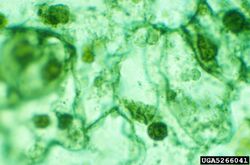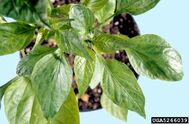| Tobacco etch virus | |
|---|---|
 |
|
| Tobbaco etch virus cell inclusion bodies | |
| Scientific Classification | |
| Family: | Potyviridae |
| Genus: | Potyvirus |
| Species: | Tobacco etch virus |
The Tobacco etch virus (TEV) is a plant pathogenic virus.
Symptoms[]
Sweet pepper & Chilli[]
All stages of plant growth are affected. The severity of symptoms depends on time of infection, the variety grown and the virus strain present. Affected pepper plants show foliar mottling or mosaic patterns, leaf distortion, and stunting. Vein-clearing and vein-banding symptoms also occur.[1]
Plants infected early have small, misshapen fruit and can be severely tunted. Fruits from such plants have severe mosaic symptoms. Tabasco pepper infected with tobacco etch virus (TEV) show root necrosis, wilting and death.[1]
Symptoms may be confused with other viruses such as potato virus Y (PVY) or pepper mottle virus (PMV).[1]
Tomato[]
Leaves may show mild mottling, crinkling, distortion, reduction in size, and pronounced downward curling. Plants infected early have shortened internodes and can be severely stunted; fruits from such plants are mottled and do not reach full size. All stages of plant growth may be affected.[2]
Prevention[]
Resistant varieties are available.
Use a nethouse or screenhouse with 32-mesh or finer to keep out aphids and to grow seedlings for transplant use. Use virus-free transplants.[1]
Minimize plant handling during the growing season to reduce the amount of virus spread mechanically.[1]
Remove nearby volunteer plants and solanaceous weeds from production fields, nearby ditch banks, hedges, fence-rows or other locations. Avoid growing other solanaceous crops especially pepper or tobacco nearby.[1]
Cultural practices include the use of organic (ie. sawdust, woodchips, and maize-cob mulches) mulches or aluminum foil mulches to reduce aphid visits to plants and thus delay virus spread. This results in reduced virus incidence and increased yields.[1]
Plant earlier to avoid high aphid populations that occur later in the season. Late plantings should be set as far as possible from fields used to produce early tomatoes and peppers, which act as sources of viruses and aphids.[1]
Monitor aphid populations early in the season and apply fast-acting insecticide treatments when needed since aphids readily transmit the virus. Use mineral oil sprays to delay virus spread in the crop by interfering with aphid transmission of the virus.[1]
Scout fields for the first occurrence of virus symptoms. If affected plants are found, spray them with a fast-acting insecticide first to prevent aphids from migrating to nearby healthy plants. Remove the affected plants, completely, and place in a plastic bag. Do not touch other plants nearby with hands, tools or clothing to prevent mechanical transmission of the virus.[1]
Disinfect tools, stakes, and equipment before moving from diseased areas to healthy areas. This can be done by:
- Soaking 10 minutes in a 1:10 dilution of a 5.25% sodium hypochlorite (household bleach), do not rinse.
- Cleaning in detergent at the concentrations recommended for washing clothes or dishes.
Keep all solutions fresh. Hands may be washed with soap or milk. Work in diseased areas last, after working in unaffected parts of a field. Wash clothing that comes into contact with virus-infected plants with hot water and a detergent.[1]
Gallery[]
References[]
- ↑ a b c d e f g h i j k Tobacco Etch Virus. AVRDC - The World Vegetable Center. Retrieved: 2010-10-22.
- ↑ Tobacco Etch Virus (TEV). AVRDC - The World Vegetable Center. Retrieved: 2010-10-22.

